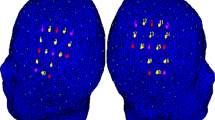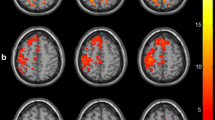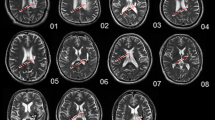Abstract
To explore alterations of resting-state functional connectivity (rsFC) in sensorimotor cortex following strokes with left or right hemiplegia considering the lateralization and neuroplasticity. Seventy-three resting-state functional near-infrared spectroscopy (fNIRS) files were selected, including 26 from left hemiplegia (LH), 21 from right hemiplegia (RH) and 26 from normal controls (NC) group. Whole-brain analyses matching the Pearson correlation were used for rsFC calculations. For right-handed normal controls, rsFC of motor components (M1 and M2) in the left hemisphere displayed a prominent intensity in comparison with the right hemisphere (p < 0.05), while for stroke groups, this asymmetry has disappeared. Additionally, RH rather than LH showed stronger rsFC between left S1 and left M1 in contrast to normal controls (p < 0.05), which correlated inversely with motor function (r = − 0.53, p < 0.05). Regarding M1, rsFC within ipsi-lesioned M1 has a negative correlation with motor function of the affected limb (r = − 0.60 for the RH group and − 0.43 for the LH group, p < 0.05). The rsFC within contra-lesioned M1 that innervates the normal side was weakened compared with that of normal controls (p < 0.05). Stronger rsFC of motor components in left hemisphere was confirmed by rs-fNIRS as the “secret of dominance” for the first time, while post-stroke hemiplegia broke this cortical asymmetry. Meanwhile, a statistically strengthened rsFC between left S1 and M1 only in right-hemiplegia group may act as a compensation for the impairment of the dominant side. This research has implications for brain-computer interfaces synchronizing sensory feedback with motor performance and transcranial magnetic regulation for cortical excitability to induce cortical plasticity.






Similar content being viewed by others
Data Availability
The datasets generated during and/or analysed during the current study are available from the corresponding author on reasonable request.
References
Arun KM, Smitha KA, Sylaja PN, Kesavadas C (2020) Identifying resting-state functional connectivity changes in the motor cortex using fNIRS during recovery from stroke. Brain Topogr 33(6):710–719. https://doi.org/10.1007/s10548-020-00785-2
Baskett JJ, Marshall HJ, Broad JB, Owen PH, Green G (1996) The good side after stroke: ipsilateral sensory-motor function needs careful assessment. Age Ageing 25(3):239–244. https://doi.org/10.1093/ageing/25.3.239
Biswal B, Zerrin Yetkin F, Haughton VM, Hyde JS (1995) Functional connectivity in the motor cortex of resting human brain using echo-planar mri. Magn Reson Med 34(4):537–541. https://doi.org/10.1002/mrm.1910340409
Bonuzzi GMG, de Freitas TB, dos Santos Palma GC, Soares MAA, Lange B, Eduardo Pompeu J, Torriani-Pasin C (2022) Effects of the brain-damaged side after stroke on the learning of a balance task in a non-immersive virtual reality environment. Physiother Theory Pract 38(1):28–35. https://doi.org/10.1080/09593985.2020.1731893
Brodtmann A, Pardoe H, Li Q, Lichter R, Ostergaard L, Cumming T (2012) Changes in regional brain volume three months after stroke. J Neurol Sci 322(1):122–128. https://doi.org/10.1016/j.jns.2012.07.019
Bu L, Huo C, Qin Y, Xu G, Wang Y, Li Z (2019) Effective connectivity in subjects with mild cognitive impairment as assessed using functional near-infrared spectroscopy. Am J Phys Med Rehabil. https://doi.org/10.1097/PHM.0000000000001118
Caldwell M, Scholkmann F, Wolf U, Wolf M, Elwell C, Tachtsidis IJN (2016) Modelling confounding effects from extracerebral contamination and systemic factors on functional near-infrared spectroscopy. Neuroimage 143:91–105. https://doi.org/10.1016/j.neuroimage.2016.08.058
Carter AR, Patel KR, Astafiev SV, Snyder AZ, Rengachary J, Strube MJ et al (2011) Upstream dysfunction of somatomotor functional connectivity after corticospinal damage in stroke. Neurorehabil Neural Repair 26(1):7–19. https://doi.org/10.1177/1545968311411054
Chen J, Schlaug G (2013) Resting state interhemispheric motor connectivity and white matter integrity correlate with motor impairment in chronic stroke. Front Neurol. https://doi.org/10.3389/fneur.2013.00178
Coelho DB, Fernandes CA, Martinelli AR, Teixeira LA (2019) Right in comparison to left cerebral hemisphere damage by stroke induces poorer muscular responses to stance perturbation regardless of visual information. J Stroke Cerebrovasc Dis 28(4):954–962. https://doi.org/10.1016/j.jstrokecerebrovasdis.2018.12.021
Cohen AD, Yang B, Fernandez B, Banerjee S, Wang Y (2021) Improved resting state functional connectivity sensitivity and reproducibility using a multiband multi-echo acquisition. Neuroimage 225:117461. https://doi.org/10.1016/j.neuroimage.2020.117461
Cui X, Bray S, Bryant DM, Glover GH, Reiss AL (2011) A quantitative comparison of NIRS and fMRI across multiple cognitive tasks. Neuroimage 54(4):2808–2821. https://doi.org/10.1016/j.neuroimage.2010.10.069
Diao Q, Liu J, Wang C, Cao C, Guo J, Han T et al (2017) Gray matter volume changes in chronic subcortical stroke: a cross-sectional study. NeuroImage: Clin 14:679–684. https://doi.org/10.1016/j.nicl.2017.01.031
Diao Q, Liu J, Zhang X (2020) Enhanced positive functional connectivity strength in left-sided chronic subcortical stroke. Brain Res 1733:146727. https://doi.org/10.1016/j.brainres.2020.146727
Dinomais M, Chinier E, Richard I, Ricalens E, Aubé C, Tich SNGT, Minassian AT (2016) Hemispheric asymmetry of supplementary motor area proper: a functional connectivity study of the motor network. Mot Control 20(1):33–49. https://doi.org/10.1123/mc.2014-0076
Duan L, Zhang Y-J, Zhu C-Z (2012) Quantitative comparison of resting-state functional connectivity derived from fNIRS and fMRI: a simultaneous recording study. Neuroimage 60(4):2008–2018. https://doi.org/10.1016/j.neuroimage.2012.02.014
Fisher RA (1915) Frequency distribution of the values of the correlation coefficient in samples from an indefinitely large population. Biometrika 10(4):507–521. https://doi.org/10.2307/2331838
Frías I, Starrs F, Gisiger T, Minuk J, Thiel A, Paquette C (2018) Interhemispheric connectivity of primary sensory cortex is associated with motor impairment after stroke. Sci Rep 8(1):12601. https://doi.org/10.1038/s41598-018-29751-6
Goodin P, Lamp G, Vidyasagar R, McArdle D, Seitz RJ, Carey LM (2018) Altered functional connectivity differs in stroke survivors with impaired touch sensation following left and right hemisphere lesions. NeuroImage: Clin 18:342–355. https://doi.org/10.1016/j.nicl.2018.02.012
Goto A, Okuda S, Ito S, Matsuoka Y, Ito E, Takahashi A, Sobue G (2009) Locomotion outcome in hemiplegic patients with middle cerebral artery infarction: the difference between right- and left-sided lesions. J Stroke Cerebrovasc Dis 18(1):60–67. https://doi.org/10.1016/j.jstrokecerebrovasdis.2008.09.003
Hammond G (2002) Correlates of human handedness in primary motor cortex: a review and hypothesis. Neurosci Biobehav Rev 26(3):285–292. https://doi.org/10.1016/S0149-7634(02)00003-9
Kim C-H, Chu H, Kang G-H, Kim K-H, Lee Y-U, Lim H-S et al (2021) Comparison of gait recovery patterns according to the paralyzed side in stroke patients: an observational study based on a retrospective chart review (STROBE compliant). Medicine (baltimore). https://doi.org/10.1097/MD.0000000000025212
Lee SH, Jin SH, An J (2019) The difference in cortical activation pattern for complex motor skills: a functional near- infrared spectroscopy study. Sci Rep 9(1):14066. https://doi.org/10.1038/s41598-019-50644-9
Levin J, Bak TH, Rominger A, Mille E, Arzberger T, Giese A et al (2015) The association of aphasia and right-sided motor impairment in corticobasal syndrome. J Neurol 262(10):2241–2246. https://doi.org/10.1007/s00415-015-7833-1
Liu J, Wang C, Qin W, Ding H, Guo J, Han T et al (2020) Corticospinal fibers with different origins impact motor outcome and brain after subcortical stroke. Stroke 51(7):2170–2178. https://doi.org/10.1161/STROKEAHA.120.029508
Lüdemann-Podubecká J, Bösl K, Theilig S, Wiederer R, Nowak DA (2015) The effectiveness of 1Hz rTMS over the primary motor area of the unaffected hemisphere to improve hand function after stroke depends on hemispheric dominance. Brain Stimul 8(4):823–830. https://doi.org/10.1016/j.brs.2015.02.004
Mani S, Mutha PK, Przybyla A, Haaland KY, Good DC, Sainburg RL (2013) Contralesional motor deficits after unilateral stroke reflect hemisphere-specific control mechanisms. Brain 136(4):1288–1303. https://doi.org/10.1093/brain/aws283
Mani S, Przybyla A, Good DC, Haaland KY, Sainburg RJ (2014) Contralesional arm preference depends on hemisphere of damage and target location in unilateral stroke patients. Neurorehabil Neural Repair 28(6):584–593. https://doi.org/10.1177/1545968314520720
Molavi B, Dumont GA (2012) Wavelet-based motion artifact removal for functional near-infrared spectroscopy. Physiol Meas 33(2):259–270. https://doi.org/10.1088/0967-3334/33/2/259
Olafson E, Russello G, Jamison KW, Liu H, Wang D, Bruss JE et al (2022) Increased prevalence of a frontoparietal brain state is associated with better motor recovery after stroke affecting dominant-hand corticospinal tract. bioRxiv. https://doi.org/10.1101/2022.02.10.479962
Oldfield RC (1971) The assessment and analysis of handedness: the Edinburgh inventory. Neuropsychologia 9(1):97–113. https://doi.org/10.1016/0028-3932(71)90067-4
Pavlides C, Miyashita E, Asanuma H (1993) Projection from the sensory to the motor cortex is important in learning motor skills in the monkey. J Neurophysiol 70(2):733–741. https://doi.org/10.1152/jn.1993.70.2.733
Piper SK, Krueger A, Koch SP, Mehnert J, Habermehl C, Steinbrink J et al (2014) A wearable multi-channel fNIRS system for brain imaging in freely moving subjects. Neuroimage 85:64–71. https://doi.org/10.1016/j.neuroimage.2013.06.062
Scholkmann F, Kleiser S, Metz A, Zimmermann R, Mata Pavia J, Wolf U, Wolf MJN (2014) A review on continuous wave functional near-infrared spectroscopy and imaging instrumentation and methodology. Neuroimage. https://doi.org/10.1016/j.neuroimage.2013.05.004
Smith R, Sanova A, Alkozei A, Lane RD, Killgore WDS (2018) Higher levels of trait emotional awareness are associated with more efficient global information integration throughout the brain: a graph-theoretic analysis of resting state functional connectivity. Soc Cognit Affect Neurosci 13(7):665–675. https://doi.org/10.1093/scan/nsy047
Tachtsidis I, Scholkmann FJN (2016) False positives and false negatives in functional near-infrared spectroscopy: issues, challenges, and the way forward. Neurophotonics 3(3):031405. https://doi.org/10.1117/1.NPh.3.3.031405
Vismara L, Cimolin V, Buffone F, Bigoni M, Clerici D, Cerfoglio S et al (2022) Brain asymmetry and its effects on gait strategies in hemiplegic patients: new rehabilitative conceptions. Brain Sci. https://doi.org/10.3390/brainsci12060798
Vos T, Lim SS, Abbafati C, Abbas KM, Abbasi M, Abbasifard M et al (2020) Global burden of 369 diseases and injuries in 204 countries and territories, 1990–2019: a systematic analysis for the Global Burden of Disease Study 2019. The Lancet 396(10258):1204–1222. https://doi.org/10.1016/S0140-6736(20)30925-9
Wise R, Chollet F, Hadar U, Friston K, Hoffner E, Frackowiak R (1991) Distribution of cortical neural networks involved in word comprehension and word retrieval. Brain 114(4):1803–1817. https://doi.org/10.1093/brain/114.4.1803%JBrain
Xu J, Liu X, Zhang J, Li Z, Wang X, Fang F, Niu H (2015) FC-NIRS: a functional connectivity analysis tool for near-infrared spectroscopy data. BioMed Res Int 2015:248724. https://doi.org/10.1155/2015/248724
Yan L-R, Wu Y-B, Hu D-W, Qin S-Z, Xu G-Z, Zeng X-H, Song H (2012) Network asymmetry of motor areas revealed by resting-state functional magnetic resonance imaging. Behav Brain Res 227(1):125–133. https://doi.org/10.1016/j.bbr.2011.11.012
Yücel M, Lühmann A, Scholkmann F, Gervain J, Dan I, Ayaz H et al (2021) Best practices for fNIRS publications. Neurophotonics 8(1):012101. https://doi.org/10.1117/1.NPh.8.1.012101
Zheng X, Luo J, Deng L, Li B, Li L, Huang DF, Song R (2021) Detection of functional connectivity in the brain during visuo-guided grip force tracking tasks: a functional near-infrared spectroscopy study. J Neurosci Res 99(4):1108–1119. https://doi.org/10.1002/jnr.24769
Ziemann U, Hallett M (2001) Hemispheric asymmetry of ipsilateral motor cortex activation during unimanual motor tasks: further evidence for motor dominance. Clin Neurophysiol 112(1):107–113. https://doi.org/10.1016/S1388-2457(00)00502-2
Acknowledgements
This work was supported by grants from the National Natural Science Foundation of China (Grant No.81972154 and No.82172536).
Author information
Authors and Affiliations
Contributions
YS carried out the conception and design of the research, YS, ZS and YD participated in the acquisition of data. YS carried out the analysis and interpretation of data and statistical analysis. YW and WS participated in obtaining funding and technical support. YS drafted the manuscript and ML and J participated in revision of manuscript for important intellectual content. All authors read and approved the final manuscript.
Corresponding author
Ethics declarations
Competing Interests
Authors declare that they have no competing interests.
Additional information
Handling Editor: Hisao Nishijo.
Publisher's Note
Springer Nature remains neutral with regard to jurisdictional claims in published maps and institutional affiliations.
Rights and permissions
Springer Nature or its licensor (e.g. a society or other partner) holds exclusive rights to this article under a publishing agreement with the author(s) or other rightsholder(s); author self-archiving of the accepted manuscript version of this article is solely governed by the terms of such publishing agreement and applicable law.
About this article
Cite this article
Song, Y., Sun, Z., Sun, W. et al. Neuroplasticity Following Stroke from a Functional Laterality Perspective: A fNIRS Study. Brain Topogr 36, 283–293 (2023). https://doi.org/10.1007/s10548-023-00946-z
Received:
Accepted:
Published:
Issue Date:
DOI: https://doi.org/10.1007/s10548-023-00946-z




